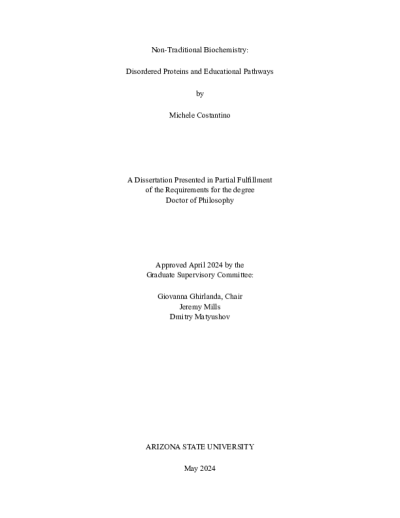ASU Electronic Theses and Dissertations
This collection includes most of the ASU Theses and Dissertations from 2011 to present. ASU Theses and Dissertations are available in downloadable PDF format; however, a small percentage of items are under embargo. Information about the dissertations/theses includes degree information, committee members, an abstract, supporting data or media.
In addition to the electronic theses found in the ASU Digital Repository, ASU Theses and Dissertations can be found in the ASU Library Catalog.
Dissertations and Theses granted by Arizona State University are archived and made available through a joint effort of the ASU Graduate College and the ASU Libraries. For more information or questions about this collection contact or visit the Digital Repository ETD Library Guide or contact the ASU Graduate College at gradformat@asu.edu.
Filtering by
- All Subjects: Biochemistry
- Creators: Matyushov, Dmitry


Temperature and polarizability effects on electron transfer in biology and artificial photosynthesis
(ET) and then provide modifications to the model. A confirmation of the inverted energy
gap law, which is the cleanest verification so far, is presented for donor-acceptor complexes.
In addition to the macroscopic properties of the solvent, the physical properties of the solvent
are incorporated in the model via the microscopic solvation model. For the molecules
studied in this dissertation, the rate constant first increases with cooling, in contrast to the
prediction of the Arrhenius law, and then decreases at lower temperatures. Additionally,
the polarizability of solute, which was not considered in the original Marcus theory, is included
by the Q-model of ET. Through accounting for the polarizability of the reactants, the
Q-model offers an important design principle for achieving high performance solar energy
conversion materials. By means of the analytical Q-model of ET, it is shown that including
molecular polarizability of C60 affects the reorganization energy and the activation barrier
of ET reaction.
The theory and Electrochemistry of Ferredoxin and Cytochrome c are also investigated.
By providing a new formulation for reaction reorganization energy, a long-standing disconnect
between the results of atomistic simulations and cyclic voltametery experiments is
resolved. The significant role of polarizability of enzymes in reducing the activation energy
of ET is discussed. The binding/unbinding of waters to the active site of Ferredoxin leads
to non-Gaussian statistics of energy gap and result in a smaller activation energy of ET.
Furthermore, the dielectric constant of water at the interface of neutral and charged
C60 is studied. The dielectric constant is found to be in the range of 10 to 22 which is
remarkably smaller compared to bulk water( 80). Moreover, the interfacial structural
crossover and hydration thermodynamic of charged C60 in water is studied. Increasing the
charge of the C60 molecule result in a dramatic structural transition in the hydration shell,
which lead to increase in the population of dangling O-H bonds at the interface.

